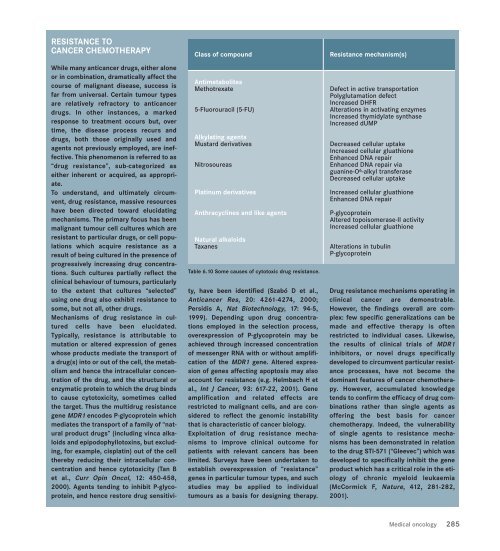world cancer report - iarc
world cancer report - iarc
world cancer report - iarc
You also want an ePaper? Increase the reach of your titles
YUMPU automatically turns print PDFs into web optimized ePapers that Google loves.
RESISTANCE TO<br />
CANCER CHEMOTHERAPY<br />
While many anti<strong>cancer</strong> drugs, either alone<br />
or in combination, dramatically affect the<br />
course of malignant disease, success is<br />
far from universal. Certain tumour types<br />
are relatively refractory to anti<strong>cancer</strong><br />
drugs. In other instances, a marked<br />
response to treatment occurs but, over<br />
time, the disease process recurs and<br />
drugs, both those originally used and<br />
agents not previously employed, are ineffective.<br />
This phenomenon is referred to as<br />
“drug resistance”, sub-categorized as<br />
either inherent or acquired, as appropriate.<br />
To understand, and ultimately circumvent,<br />
drug resistance, massive resources<br />
have been directed toward elucidating<br />
mechanisms. The primary focus has been<br />
malignant tumour cell cultures which are<br />
resistant to particular drugs, or cell populations<br />
which acquire resistance as a<br />
result of being cultured in the presence of<br />
progressively increasing drug concentrations.<br />
Such cultures partially reflect the<br />
clinical behaviour of tumours, particularly<br />
to the extent that cultures “selected”<br />
using one drug also exhibit resistance to<br />
some, but not all, other drugs.<br />
Mechanisms of drug resistance in cultured<br />
cells have been elucidated.<br />
Typically, resistance is attributable to<br />
mutation or altered expression of genes<br />
whose products mediate the transport of<br />
a drug(s) into or out of the cell, the metabolism<br />
and hence the intracellular concentration<br />
of the drug, and the structural or<br />
enzymatic protein to which the drug binds<br />
to cause cytotoxicity, sometimes called<br />
the target. Thus the multidrug resistance<br />
gene MDR1 encodes P-glycoprotein which<br />
mediates the transport of a family of “natural<br />
product drugs” (including vinca alkaloids<br />
and epipodophyllotoxins, but excluding,<br />
for example, cisplatin) out of the cell<br />
thereby reducing their intracellular concentration<br />
and hence cytotoxicity (Tan B<br />
et al., Curr Opin Oncol, 12: 450-458,<br />
2000). Agents tending to inhibit P-glycoprotein,<br />
and hence restore drug sensitivi-<br />
Class of compound Resistance mechanism(s)<br />
Antimetabolites<br />
Methotrexate Defect in active transportation<br />
Polyglutamation defect<br />
Increased DHFR<br />
5-Fluorouracil (5-FU) Alterations in activating enzymes<br />
Increased thymidylate synthase<br />
Increased dUMP<br />
Alkylating agents<br />
Mustard derivatives Decreased cellular uptake<br />
Increased cellular gluathione<br />
Enhanced DNA repair<br />
Nitrosoureas Enhanced DNA repair via<br />
guanine-O 6-alkyl transferase<br />
Decreased cellular uptake<br />
Platinum derivatives Increased cellular gluathione<br />
Enhanced DNA repair<br />
Anthracyclines and like agents P-glycoprotein<br />
Altered topoisomerase-II activity<br />
Increased cellular gluathione<br />
Natural alkaloids<br />
Taxanes Alterations in tubulin<br />
P-glycoprotein<br />
Table 6.10 Some causes of cytotoxic drug resistance.<br />
ty, have been identified (Szabó D et al.,<br />
Anti<strong>cancer</strong> Res, 20: 4261-4274, 2000;<br />
Persidis A, Nat Biotechnology, 17: 94-5,<br />
1999). Depending upon drug concentrations<br />
employed in the selection process,<br />
overexpression of P-glycoprotein may be<br />
achieved through increased concentration<br />
of messenger RNA with or without amplification<br />
of the MDR1 gene. Altered expression<br />
of genes affecting apoptosis may also<br />
account for resistance (e.g. Helmbach H et<br />
al., Int J Cancer, 93: 617-22, 2001). Gene<br />
amplification and related effects are<br />
restricted to malignant cells, and are considered<br />
to reflect the genomic instability<br />
that is characteristic of <strong>cancer</strong> biology.<br />
Exploitation of drug resistance mechanisms<br />
to improve clinical outcome for<br />
patients with relevant <strong>cancer</strong>s has been<br />
limited. Surveys have been undertaken to<br />
establish overexpression of “resistance”<br />
genes in particular tumour types, and such<br />
studies may be applied to individual<br />
tumours as a basis for designing therapy.<br />
Drug resistance mechanisms operating in<br />
clinical <strong>cancer</strong> are demonstrable.<br />
However, the findings overall are complex:<br />
few specific generalizations can be<br />
made and effective therapy is often<br />
restricted to individual cases. Likewise,<br />
the results of clinical trials of MDR1<br />
inhibitors, or novel drugs specifically<br />
developed to circumvent particular resistance<br />
processes, have not become the<br />
dominant features of <strong>cancer</strong> chemotherapy.<br />
However, accumulated knowledge<br />
tends to confirm the efficacy of drug combinations<br />
rather than single agents as<br />
offering the best basis for <strong>cancer</strong><br />
chemotherapy. Indeed, the vulnerability<br />
of single agents to resistance mechanisms<br />
has been demonstrated in relation<br />
to the drug STI-571 (“Gleevec”) which was<br />
developed to specifically inhibit the gene<br />
product which has a critical role in the etiology<br />
of chronic myeloid leukaemia<br />
(McCormick F, Nature, 412, 281-282,<br />
2001).<br />
Medical oncology 285

















